
Asteroids is a space-themed multidirectional shooter arcade video game designed by Lyle Rains and Ed Logg released in November 1979 by Atari, Inc. The player controls a single spaceship in an asteroid field which is periodically traversed by flying saucers. The object of the game is to shoot and destroy the asteroids and saucers, while not colliding with either, or being hit by the saucers' counter-fire. The game becomes harder as the number of asteroids increases.
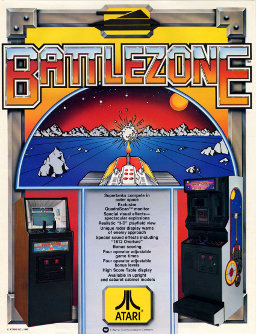
Battlezone is a first-person shooter tank combat game released for arcades in November 1980 by Atari, Inc. The player controls a tank which is attacked by other tanks and missiles. Using a small radar scanner along with the terrain window, the player can locate enemies and obstacles around them in the barren landscape. Its innovative use of 3D graphics made it a huge hit, with approximately 15,000 cabinets sold.

Defender is a horizontally scrolling shooter developed by Williams Electronics in 1980 and released as an arcade video game in 1981. The game is set on either an unnamed planet or city where the player must defeat waves of invading aliens while protecting astronauts. Development was led by Eugene Jarvis, a pinball programmer at Williams; Defender was Jarvis's first video game project and drew inspiration from Space Invaders and Asteroids. Defender was demonstrated in late 1980, before entering production in early 1981. It was distributed in Japan by Taito.
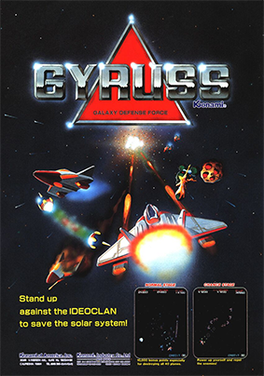
Gyruss is shoot 'em up arcade video game designed by Yoshiki Okamoto and released by Konami in 1983. Gyruss was initially licensed to Centuri in the United States for dedicated machines, before Konami released their own self-distributed conversion kits for the game. Parker Brothers released contemporary ports for home systems. An enhanced version for the Family Computer Disk System was released in 1988, which was released to the North American Nintendo Entertainment System in early 1989.
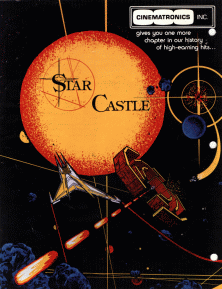
Star Castle is a vector graphics multidirectional shooter released in arcades by Cinematronics in 1980. The game involves obliterating a series of defenses orbiting a stationary turret in the center of the screen. The display is black and white with the colors of the rings and screen provided by a transparent plastic screen overlay.

Star Wars is a first-person rail shooter designed by Mike Hally and released as an arcade video game in 1983 by Atari, Inc. It uses 3D color vector graphics to simulate the assault on the Death Star from the 1977 film Star Wars. There are three connected gameplay sequences: combat against TIE fighters in space, flying across the surface of the Death Star, and the final trench run. The sequence repeats with added complications and the Death Star regenerating for each. The player's X-Wing fighter has a shield which only protects against damage a certain number of times, then the next hit ends the game. Speech synthesis emulates actors from the film.

Gravitar is a color vector graphics multidirectional shooter arcade video game released by Atari, Inc. in 1982. Using the same "rotate-and-thrust" controls as Asteroids and Space Duel, the game was known for its high level of difficulty. It was the first of over twenty games Mike Hally designed and produced for Atari. The main programmer was Rich Adam and the cabinet art was designed by Brad Chaboya. Over 5,427 cabinets were produced. An Atari 2600 version by Dan Hitchens was published by Atari in 1983.

Mine Storm is a multidirectional shooter similar to Atari, Inc.'s 1979 Asteroids arcade game. Designed and programmed by John Hall, it was published in 1982 by General Consumer Electronics as the built-in game for the Vectrex system. Although not provided on a physical cartridge, a Mine Storm screen overlay and manual were included with each system to support the built-in game.

Liberator is an arcade game released by Atari, Inc. in 1982. It is based on the Atari Force comic book series published by DC Comics from 1982 to 1986. Liberator has been described as the opposite of Missile Command, in that the player destroys cities from space instead of defending them from the ground. Only 762 arcade machines were ever made.

Star Wars: The Empire Strikes Back is the sequel to the vector graphics Star Wars arcade video game released by Atari, Inc. in 1983. It was made available by Atari Games in 1985 as a conversion kit for the original game. As in Star Wars, the player takes on the role of Luke Skywalker in a set of battle sequences from a first-person perspective. The game features the Battle of Hoth and the subsequent escape of the Millennium Falcon through an asteroid field. It is the third Star Wars arcade title from Atari; the raster game Return of the Jedi came out the previous year.

Blasteroids is the third official sequel to the 1979 multidirectional shooter video game, Asteroids. It was developed by Atari Games and released in arcades in 1987. Unlike the previous games, Blasteroids uses raster graphics instead of vector graphics, and has power-ups and a boss.
Blaster is a first-person rail shooter released as an arcade video game by Williams Electronics in 1983. It was developed by Eugene Jarvis and Larry DeMar. A vague sequel to Robotron: 2084, the game is a shoot 'em up set in outer space. The goal is to destroy enemies, avoid obstacles, and rescue astronauts in twenty levels, to reach paradise.

Space Fury is a 1981 multidirectional shooter arcade game developed by Gremlin. Sega/Gremlin released the game in North America in June 1981, and then Sega released it in Japan in July 1981. It is the first game with color vector graphics, and it was Sega's second game to use speech synthesis. Coleco published a ColecoVision version with raster graphics in 1983.

Space Duel is an arcade game released in 1982 by Atari, Inc. It is a direct descendant of the original Asteroids, with asteroids replaced by colorful geometric shapes like cubes, diamonds, and spinning pinwheels. Space Duel is the first and only multiplayer vector game by Atari. When Asteroids Deluxe did not sell well, this game was taken off the shelf and released to moderate success.

Astro Chase is a multidirectional shooter written by Fernando Herrera for Atari 8-bit computers. It was published by First Star Software in 1982 as the company's first game. Parker Brothers licensed it, releasing cartridge versions for the Atari 8-bit family and Atari 5200 console in 1983 and a Commodore 64 version in 1984. Exidy licensed it for arcade use with its Max-A-Flex cabinet.
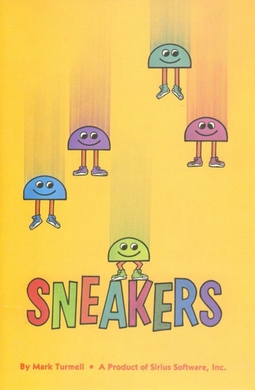
Sneakers is a fixed shooter video game for the Apple II written by Mark Turmell and published by Sirius Software in 1981. A version for Atari 8-bit computers was released the same year. Sneakers was Turmell's first published game. He later was the lead designer and programmer of 1993's NBA Jam.

Starship 1 is a first-person shooter space combat game developed and manufactured for arcades in 1977 by Atari, Inc. The game, which takes great inspiration from the then very popular television series Star Trek, contains the first known Easter egg in any arcade game. The arcade game was distributed in Japan by Namco in 1978, and it was ported to the Atari 2600 as Star Ship.
Lunar Rescue is an arcade game released by Taito in November 1979. The gameplay has some resemblance to both Taito's own 1978 hit Space Invaders and Atari, Inc.'s Lunar Lander.
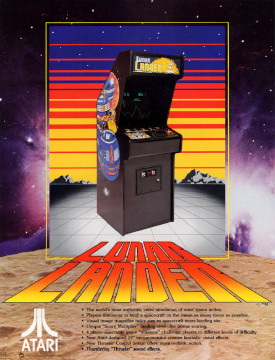
Lunar Lander is a single-player arcade game in the Lunar Lander subgenre. It was developed by Atari, Inc. and released in August 1979. It was the most popular version to date of the "Lunar Lander" concept, surpassing the prior Moonlander (1973) and numerous text-based games, and most later iterations of the concept are based on this Atari version.
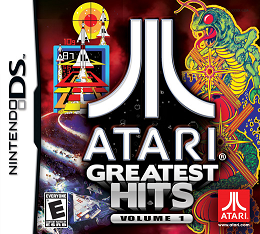
The Atari Greatest Hits series is composed of two compilations of retro Atari arcade games & Atari 2600 games ported to the Nintendo DS. While listed on the Atari web site as free for iOS & Android, Atari Greatest Hits has been removed from both app stores.

















